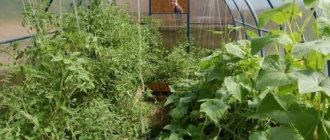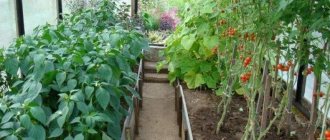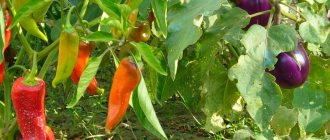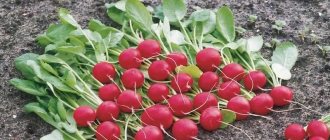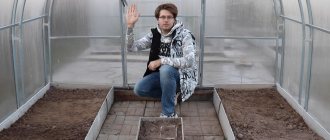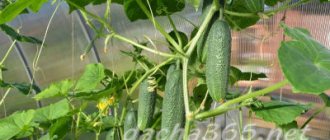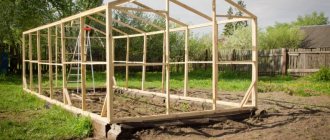OgorodGuruCom
Tips and tricks for gardeners
Popular
Feeding pepper seedlings with ash at home
Home › Vegetables › Is it possible to plant peppers and tomatoes in the same greenhouse
Is it possible to plant peppers next to tomatoes? A similar question worries those gardeners who do not have much space on their plot, but still need to place these crops. Is joint boarding allowed, the main nuances and rules, all this is discussed in the article.
Is it possible to plant peppers and tomatoes in the same greenhouse?
Growing vegetables in greenhouses allows you to get the harvest much earlier, protect against temperature changes, and also artificially create the necessary conditions for growing. To achieve a harvest, plants with similar agricultural technology requirements are combined in one greenhouse.
When choosing neighbors for a greenhouse, consider:
- Growth of grown crops. During the growing season, light must reach the plants equally.
- Need for hydration. The frequency of watering and the required level of humidity must match.
- The temperature should be similar.
Since peppers and tomatoes are nightshade plants, they can be planted nearby. Productivity depends on well-formed plantings and proper care.
Botanical description of tomato
Also belonging to the Solanaceae family is a herbaceous plant called tomato. Grown as an annual (temperate latitudes) or perennial (tropical zone).
The vegetable crop has a tap root, highly branched, penetrating to a considerable depth. Depending on the varietal characteristics, the herbaceous stem can be erect, lodging, or branching. The height of the crop varies from 30 to 200 cm. The leaves are dissected, odd-pinnate, covered with glandular hairs. Based on the type of bush structure, standard, non-standard and potato varieties are distinguished.
The tomato belongs to the group of facultative pollinators. Cross pollination occurs in regions with hot, dry climates. The fruits of the crop are multi-locular berries of a cylindrical or flat-round shape. The weight of a ripe tomato is determined by its varietal qualities: from 50 to 800 grams. Larger specimens are also found. The color of a tomato that has reached maturity can be various shades of red, pink, and crimson. Hybrids have been bred using selective methods, the fruits of which attract attention with white, light green, yellow, golden, orange and even brown colors.
The nuances of joint cultivation
May be interesting Kamensky Potatoes: description and characteristics, reviews Pepper “Gift of Moldova” - a gift from breeders Trichopolum and Metronidazole for processing and treating cucumbers
To reap a good harvest of two crops at once, the plants are provided with proper care. There are many options when placing seedlings rationally. When choosing a specific method, they are guided solely by the comfort of the seedlings.
When arranging seedlings, they are guided by the following rules:
- tall varieties should not shade shorter plants;
- tomatoes are planted so that they can be ventilated later, for example, near paths;
- peppers are placed near the walls of the shelter, where there is practically no air flow;
- parts of the bushes should not touch each other.
It is best to form separate beds.
Since in the 2nd half of summer there is a high risk of developing late blight, tomatoes are ventilated as often as possible. At this time, the peppers are fenced off, for example, with polyethylene film.
When planting peppers and tomatoes in the same greenhouse, it is advisable to stagger the bushes. Initially, tomatoes are planted and allowed to adapt for 2-3 weeks. Remove the lower tier of leaves from the tomato and then you can plant the pepper seedlings. This will provide free access to light to the young peppers.
Preparatory work
To grow two vegetables in a shelter at once, the preparatory procedures must be taken responsibly; the plants should not interfere with each other. Pre-select varieties and think about the location.
First of all, prepare the soil correctly (minerals and trace elements are added as much as possible). Since tomatoes and peppers love heat, add more peat to the soil (this component should retain heat as much as possible).
Preparing the landing site
To plant peppers in a greenhouse along with tomatoes, various types of shelters are used. These can be polycarbonate or glass greenhouses or film greenhouses. The structure is made high so that the tomatoes can fully develop in it.
Much attention is paid to the arrangement of greenhouses. They should be lighted and well ventilated.
Variety selection
Plant species are often chosen based on the area of shelter. If space in the greenhouse is limited, then tall tomatoes and low-growing peppers are purchased. In this case, different plants are allowed to be grown in 1 bed.
On a note!
The following pepper varieties are suitable for planting in shelters: Chanterelle, Lastochka, Eroshka, Fakir, Izaboella, Apricot favorite. Tomatoes Zhenaros, Aksinya, Typhoon, Evpator, Pablo are suitable for growing together.
Priming
You can pour store-bought soil into the greenhouse. They successfully prepare the soil for a greenhouse on their own. It should contain a lot of peat, which perfectly retains heat, which is beneficial for each crop.
The soil is kept loose and slightly moist. The soil base can be loamy or clay soil; sawdust, peat, and humus are added in different proportions. The consumption for each square of shelter is 3 buckets of prepared substrate.
Recommendations
In order for plants to adapt to such a neighborhood as best as possible, it is worth following a number of rules:
- The greenhouse itself should be located in the south
- It is recommended to place the beds in the direction from north to south
- The height of the beds must be at least 20 cm, and the top layer of soil must be discarded, exactly the same as for open ground.
- In order to retain heat in the ground, you need to fertilize the ground with manure; for the same purpose, it is recommended to equip the greenhouse with the simplest heating system; even in May there may be frosts
- In order for air to penetrate into the soil better, it is recommended to sow green manure into the ground immediately after harvesting, this will have a positive effect on the structure of the soil
Organization of landing
Proper delimitation of space is one of the important conditions for growing together. They also take care of organizing the correct microclimate. If it is not possible in the greenhouse to organize a separate bed for each crop, then choose another option.
We separate cultures with film
The easiest way to delimit space between crops is to use a partition, for example, made of plastic film. Install it from the ground to the roof. Thanks to the overlap, they create a comfortable microclimate for peppers and tomatoes.
The film impedes the flow of air. Personal exits are organized for the zones, preferably at the ends of the beds.
It is important not only to delimit the space, but also the soil. The beds are made so that they are located on different sides (a passage is made between them). If this does not work, then separate the roots with slate or metal.
Growing without divisions
Plant peppers and tomatoes without stretching the film. Correctly distribute the greenhouse space. Pepper is placed in the southern part of the greenhouse, as it loves warmth.
Tomatoes are planted in the northern and central parts. The plant is not afraid of drafts; they can be safely placed near openings. You can additionally plant radishes, garlic, and beans in such a greenhouse.
On a note!
When planning a greenhouse, bitter peppers are never placed next to sweet varieties. Also, do not plant cucumbers and eggplants together.
Can these vegetables be planted together?
How recommended is this?
Reference . Tomatoes and peppers get along quite well together, since both belong to the nightshade family. Therefore, we can definitely recommend growing them together in a greenhouse.
It only takes a little effort to provide conditions that are simultaneously suitable for the healthy development of both plants.
Advantages and disadvantages
pros:
Tomatoes secrete special essential oils that are intolerable to aphids, which has a beneficial effect on peppers that are susceptible to their attacks.- The size of the crops allows you to combine both types in one bed, which significantly saves space.
Minuses:
- Only sweet varieties of peppers can be planted together with tomatoes. Bitter varieties will negatively affect the taste of tomatoes during pollination.
- Pepper loves moist soil, but it is destructive for tomatoes. Therefore, it will be necessary to constantly maintain a delicate balance in soil moisture saturation in order to ensure comfort for both crops.
Pests
By placing crops in one shelter, there is a possibility of developing diseases, as well as damage to crops by pests. The most common guests are aphids and slugs.
Fighting aphids
Aphid infestation occurs in summer (August). If colonies of pests appear on the leaves, then take action immediately. Choose the most effective remedy.
- “Healthy Garden” product. Bushes are bred and processed. Aphids become active in the evening, so it is better to spray during this period.
- Fitoverm (Iskra Bio). Helps quickly deal with aphids on peppers and tomatoes. Fitoverm drops after treatment are absorbed into the green part of the plants, which protects for about 3 weeks.
Phytoferm can be used not only in the fight against aphids, but also other garden pests. On the third day, vegetables after processing can be used.
Slugs
It is very common for slugs and snails to end up in a greenhouse, especially when grown together. They rarely eat tomatoes, but they don’t mind eating peppers. If holes and tunnels appear in the fruits, then this is the work of slugs.
Slate sheets are used. They line the passages. By evening, slugs will accumulate on the surface of the sheets; you just need to turn them over and crush the pests.
On a note!
Dead slugs are not collected; they are used as bait for their relatives. The rest will crawl in. It will be possible to destroy many slugs and snails at once.
Is there still snow? Do not hurry!
The most natural winter treatment of greenhouse soil, as intended by nature, is snow. Here's how much work this collection of fragile snowflakes does:
- Almost all insect larvae and weed roots die under the snow in winter.
- But beneficial microorganisms usually overwinter well under snow.
- The gradual melting of snow evenly nourishes the entire soil thickness with distilled water.
- The water obtained in this way significantly reduces soil salinization.
So if you don't want your vegetables too early, let the snow do its job - you'll have a healthier, richer harvest.
Diseases
In addition to pests, joint plantings in a greenhouse suffer from diseases, especially fungal ones, more often than in open ground. In favorable greenhouse conditions, spores quickly begin to multiply, destroying the crop.
- Late blight. A fungal disease that quickly provokes rotting processes. It spreads quickly in conditions of high humidity and with too frequent watering.
- Brown spot. A fungal disease that manifests itself as brown dry spots on the leaves.
- Phytoplasmosis. This disease is caused by aphids and spider mites if they are not destroyed when they appear. The bushes do not grow, the leaves curl, the fruits are deformed. Insecticides are used to control pests.
Do not wait for the first signs of disease to appear. If possible, carry out preventive treatment of plants with fungicides (the drug Fitosporin), and also do not violate the principles of care.
Determining factor: soil temperature
The most popular mistake beginners make is to plant seedlings in fairly cold greenhouse beds when the air itself seems warm. This is really a catch, because, it would seem, according to the laws of physics, first the earth is heated by the sun’s rays, and then the surrounding air is heated by it. And this is true, and the soil may indeed feel ready to the touch for growing plants on it, but we often forget that the roots are at depth. And it's cold there.
Take a regular outdoor thermometer and stick it into the greenhouse beds. Preferably to a depth of 10-15 cm, where the roots will fall first (and in an adult plant they will reach all of 60-80 cm, no doubt). So what's the temperature now? Around +10°C? Plant plants and they will stop their development for a long time.
It's all about stress from unexpected unfavorable conditions. Nature is smart, and a plant that has fallen from ideal conditions into frozen ground “thinks” that winter has come. Therefore, it quickly curtails its main functions and falls into real hibernation. How long will it take you to “wake him up” then!
And due to the extended adaptation period, fruiting will occur much later. And why then a greenhouse, when the same result could be achieved in the open air? Moreover, the harvest itself from such bushes, unfortunately, will not please you.
Therefore, soil temperature is a really important factor. Let's list exactly what it should be for a wide variety of seedlings:
- Cucumbers: +18°C during the day and +16°C at night.
- Tomatoes: +15°C during the day and +14°C at night.
- Eggplants: +18°C during the day and +16°C at night.
- Pepper: +15°C during the day and +14°C at night.
- Onion: +10°C during the day and +8°C at night.
More accurately:
The nuances of joint care
Cultures belong to the same family. However, their care rules differ. There are small nuances that are taken into account when growing two plants at once in one closed space.
Fertilization and watering
Tomatoes do not like high humidity (maximum 600), they do not tolerate repeated watering and waterlogging. And pepper perfectly forms a harvest at high and low humidity. It is not afraid of excess liquid and moisture on the leaves.
The plants are fertilized for the first time 2 weeks after planting. Feed with mullein solution (0.5 l of liquid mullein and 1 tbsp of nitrophosphate are diluted per 10 liters of water). Water the bushes near the trunk. After 10-14 days, another fertilizing with potassium superphosphate is performed. It is repeated 3 times per season.
Shaping and tying
In greenhouses, bushes are formed so that the plants fully develop and bear fruit. Stepchildren and lower leaves are removed. No more than 5 shoots are retained on the main stem. In about a month, pinch off the top.
Tall and medium-sized plant varieties must be tied up. In some situations, suspension is used. If the load of fruits on the stem is very large, then even low-growing bushes are tied up.

